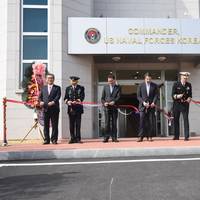Carl Vinson Carrier Strike Group Returns from WESTPAC
The aircraft carrier USS Carl Vinson (CVN 70), Ticonderoga class guided-missile cruiser USS Lake Champlain (CG 57), Arleigh Burke-class guided-missile destroyer USS Wayne E. Meyer (DDG 108), along with embarked Carrier Strike Group (CSG) 1, Carrier Air Wing (CVW) 2, and Destroyer Squadron (DESRON) 1 arrived in San Diego June 23, following a five-and-a-half-month deployment to the Western Pacific. Carl Vinson, Lake Champlain, Wayne E. Meyer and embarked air wing and staffs departed San Diego for a regularly-scheduled deployment with the Carl Vinson Carrier Strike Group as part of the U.S. Pacific Fleet-led initiative to extend the command and control functions of U.S. 3rd Fleet into the Indo-Asia-Pacific region, Jan.
New Era of US, ROK Navy Alliance Begins in Busan
Commander, U.S. Naval Forces Korea (CNFK) conducted a ribbon-cutting ceremony Feb. 19, officially opening its headquarters in Busan and ushering in a new era of U.S. and Republic of Korea Navy (ROKN) alliance. The ceremony, attended by dignitaries and senior U.S. and ROK military leaders, marked the completion of CNFK's relocation to Busan making it the only U.S. military headquarters in Korea located on a ROK base. "Five years in the planning, but 59 years in the making, Commander Naval Forces Korea is home in Busan," Rear Adm. Bill Byrne, commander of CNFK, said. The relocation from Seoul to Busan enhances the alliance between the ROK and U.S. navies by enabling closer collaboration and communication and reinforces the strong relationship between the partner navies.
US Bolsters Navy Alliance with Korea

Commander, U.S. Naval Forces Korea (CNFK) conducted a ribbon-cutting ceremony February 19, officially opening its headquarters in Busan and ushering in a new era of U.S. and Republic of Korea Navy (ROKN) alliance. The ceremony, attended by dignitaries and senior U.S. and ROK military leaders, marked the completion of CNFK's relocation to Busan making it the only U.S. military headquarters in Korea located on a ROK base. "Five years in the planning, but 59 years in the making, Commander Naval Forces Korea is home in Busan," Rear Adm. Bill Byrne, commander of CNFK, said.
U.S., Korea Conclude Exercise Clear Horizon
Helicopter Mine Countermeasures Squadron (HM) 14, Detachment 1, and Mine Countermeasure Squadron (MCMRON) 7, completed the bilateral mine countermeasures exercise Clear Horizon with the Republic of Korea (ROK) Navy, Nov. 13. Exercise Clear Horizon is an annual bilateral exercise between the U.S. and ROK navies that focus on increasing capabilities and coordination between ships, and aircraft in mine countermeasures in international waters surrounding the Korean peninsula. "This exercise is a testament to the strong partnership between the U.S. and our ROK partners," said Rear Adm. Bill Byrne, the commander of Naval Forces Korea. Approximately 330 U.S.
'USS Nimitz' Shows the Flag in Korea

The U.S. nuclear-powered aircraft carrier arrives to participate in joint naval drills as part of routine training according to the Combined Forces Command. The 97,000-ton Nimitz, one of the world's largest warships, made a port call at the southeastern port city of Busan for a three-day stay to participate in joint military drills in southern and eastern waters of the Korean Peninsula. Carrier Strike Group (CSG) 11 is comprised of the aircraft carrier USS Nimitz (CVN 68) along with embarked Carrier Air Wing 11…
Nimitz CSG Ships Arrive in South Korea

The aircraft carrier USS Nimitz (CVN 68) is moored near the Republic of Korean submarine Sohn Won-il (SSK 072) at Busan Naval Base. The nuclear-powered aircraft carrier is taking part in Exercise Key Resolve/Foal Eagle 2008, an annual joint exercise involving forces from the U.S. and the ROK. U.S. USS Nimitz (CVN 68), USS Princeton (CG 59) and USS John Paul Jones (DDG 53) arrived in Busan, Feb. 28, for a scheduled port visit in conjunction with exercise Key Resolve/Foal Eagle 2008 (KR/FE 08).
Combined Efforts Bring Warmth to Icy Waters
Divers attached to the U.S. Navy Diving Team, Mobile Diving and Salvage Unit 1, Detachment 1 (MDSU 1 DET 1), and the Republic of Korea (ROK) Navy Diving Team found common ground underwater during training off the coast here March 22-30. Deployed from Naval Station San Diego, MDSU 1 divers conducted training that involved integrating with the ROK Navy divers to practice cutting and welding operations, force protection, side-scan sonar operations and pier evaluations. Lt. Stephen Schwedhelm, officer in charge of MSDU 1, described the importance of pier evaluations, which he describes as sending divers in the water to evaluate the structural integrity of the pier.
U.S., ROK Navies Perfect Warfighting Skills
Personnel and units of the U.S. military and Republic of Korea (ROK) Combined Forces Command (CFC) conducted their annual combined and joint exercise, Reception, Staging, Onward-movement, & Integration and Foal Eagle 2006 (RSOI/Foal Eagle 06) March 24-31. RSOI and Foal Eagle are Korean-theaterwide computer-simulated and field exercises designed to evaluate and improve the U.S. and ROK forces' ability to coordinate the procedures, plans and systems necessary to defend the ROK in a contingency. It focuses on ground maneuver, air, naval, expeditionary, and special operations, as well as command and control training. Foal Eagle involved more than 70 U.S. and ROK Navy ships and more than 100 aircraft from all services of both the U.S. and ROK armed forces.






